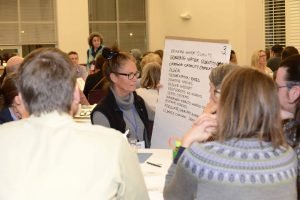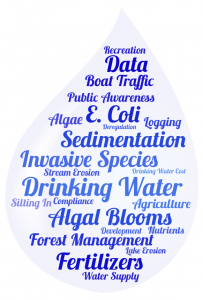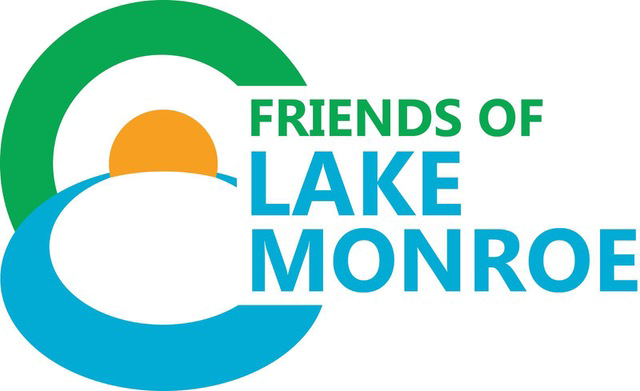2nd Quarter Update Part 2 - Community Concerns
Community Concerns about Lake Monroe Thank you very much to all the community members who participated in our two Lake Monroe Community Forums this winter! These forums were held in partnership with the amazing League of Women Voters chapters in Monroe and Brown Counties. Over 100 community members attended and shared their concerns about Lake Monroe.Forum attendees were divided into groups and asked to brainstorm their concerns. Then each group was asked to prioritize their top 3-4 concerns. The watershed coordinator compiled the top concerns and removed duplicates to create this list of 45 concerns.
Thank you very much to all the community members who participated in our two Lake Monroe Community Forums this winter! These forums were held in partnership with the amazing League of Women Voters chapters in Monroe and Brown Counties. Over 100 community members attended and shared their concerns about Lake Monroe.Forum attendees were divided into groups and asked to brainstorm their concerns. Then each group was asked to prioritize their top 3-4 concerns. The watershed coordinator compiled the top concerns and removed duplicates to create this list of 45 concerns.
| Category | Concern |
| Drinking Water | Drinking water quality (nitrates, phosphates, dangerous bacteria, E. coli, toxic blue-green algae) |
| Drinking water treatment costs as a homeowner | |
| Taste and odor issues with drinking water | |
| Actual ownership of water; ensure water stays here | |
| Fear that lake water would be so undrinkable so it is no longer available as our water supply | |
| Algae blooms affect drinking water treatment | |
| Sedimentation, Siltation, & Erosion | Silting in of lake – can we stop it |
| Lake getting more shallow due to sedimentation | |
| Need to quantify siltation rate and identify source(s) | |
| Shoreline erosion | |
| Sedimentation/erosion - entire watershed | |
| Nutrients & Algae | Algae blooms caused by nutrient loading make the lake unswimmable |
| Nutrient loading (urban lawns, agriculture, septic systems) | |
| Inappropriate agricultural practices | |
| Lawn maintenance (and its downstream effects) | |
| Effects of septic systems on nutrient loading | |
| Pathogens & E coli | Waterways are not up to standards; clean up E coli |
| Pathogens from humans and animals | |
| Failed septic systems | |
| Ensure that boat toilets are properly sealed | |
| Pollution - Chemicals & Trash | Trash and plastic pollution |
| Need to quantify what chemicals/pollutants are entering lake | |
| Use of herbicides/pesticides in residential/commercial | |
| Toilet flush of prescription pharmaceuticals | |
| Development | Development on and around the lake |
| Forestry | Effects of logging |
| Keep forests as forests | |
| Unregulated forest management | |
| Logging/forest management (herbicides – amphibians, heavy equipment – road damage) | |
| Invasive Species | Invasive plants |
| Asian Carp | |
| Effects of invasive species control | |
| Lack of Knowledge/Education | Poor public understanding of how lakes/watersheds function |
| Educate public and school children | |
| Need more data about water quality and trends | |
| Lake Management/Jurisdiction | Lack of oversight/enforcement of polluters, landowners |
| Uneven distribution of economic return from the lake | |
| Long-term management plan implementation, monitoring, and funding | |
| No drainage ordinance | |
| Deregulation of environmental protection | |
| Collaboration between multiple governments required for implementation; unclear who is in charge | |
| Recreation | Maintain recreational value |
| Recreational pollution - how to limit effects, dispel myths | |
| Recreation - boating impacts; responsible use | |
| Large boat engines contribute to erosion, turbidity |
 Lake Monroe is the sole source of drinking water for over 120,000 people and attracts nearly 1,000,000 people annually as a recreational destination so it’s no surprise that concerns about drinking water and recreational value were at the top of the list. Algal blooms have been detected multiple times in Lake Monroe, leading to the issuance of recreational advisories and raising concerns about drinking water treatment. Erosion of the lakeshore is evident in many places. Sedimentation and siltation are a concern for every reservoir due to the potential of a lake silting in. E. Coli is a concern for several streams in the larger watershed.The next step in the project is attempting to quantify and evaluate each concern. How significant is the problem? Where are the pollutants (nutrients, sediment, E. coli) coming from? What data can we find in existing studies and what additional data can we collect in the field as part of this project?One way we are collecting data is through two volunteer-driven sampling blitzes. Our Spring 2020 Sampling Blitz was postponed due to the COVID-19 pandemic. However, on September 18th we plan to collect water samples from over 100 stream crossings throughout the watershed. A second blitz will be scheduled for the spring of 2021. These citizen science events provide a snapshot of water quality in different tributaries and help identify potential source areas. Additional sampling will be conducted by staff from the Indiana University Limnology Lab. Starting in April, they will be collecting water samples monthly from four streams that feed into Lake Monroe – North Fork Salt Creek, Middle Fork Salt Creek, South Fork Salt Creek, and Crooked Creek. In the summer, they will also collect samples from within the lake for comparison with previous years and to use in calculations estimating what percentage of pollutants are coming from which streams. Specialized testing will be done on select E. coli samples from throughout the watershed to determine if the E. coli is coming from humans or animals (cow, horse, dog, etc.).In addition to collecting and analyzing water samples, we are conducting site inspections throughout the watershed to identify areas of concern. This includes evaluating over 300 stream crossings to identify stretches of extreme erosion as well as making observations of land use to identify any properties that could benefit from improved land management practices. Ultimately, this data will be used to identify contamination sources (e.g. sediment generated by stream bank erosion vs lakeshore erosion) and also identify specific geographic areas of concern.How can you participate? Sign up for the Friends of Lake Monroe newsletter or follow us on Facebook to hear about upcoming events and volunteer opportunities. Join us at a public meeting – July 15, and September 16 in Bloomington plus a special meeting to be held in Brown County this fall. Volunteer at our water sampling blitzes this fall (September 18) and next spring (date TBD). Consider becoming a member of Friends of Lake Monroe.Thank you for your support of our work to create a watershed management plan for the lake. If you have questions or comments, please don’t hesitate to reach out to watershed coordinator Maggie Sullivan at watershed@friendsoflakemonroe.org or by phone at (812) 558-0217.
Lake Monroe is the sole source of drinking water for over 120,000 people and attracts nearly 1,000,000 people annually as a recreational destination so it’s no surprise that concerns about drinking water and recreational value were at the top of the list. Algal blooms have been detected multiple times in Lake Monroe, leading to the issuance of recreational advisories and raising concerns about drinking water treatment. Erosion of the lakeshore is evident in many places. Sedimentation and siltation are a concern for every reservoir due to the potential of a lake silting in. E. Coli is a concern for several streams in the larger watershed.The next step in the project is attempting to quantify and evaluate each concern. How significant is the problem? Where are the pollutants (nutrients, sediment, E. coli) coming from? What data can we find in existing studies and what additional data can we collect in the field as part of this project?One way we are collecting data is through two volunteer-driven sampling blitzes. Our Spring 2020 Sampling Blitz was postponed due to the COVID-19 pandemic. However, on September 18th we plan to collect water samples from over 100 stream crossings throughout the watershed. A second blitz will be scheduled for the spring of 2021. These citizen science events provide a snapshot of water quality in different tributaries and help identify potential source areas. Additional sampling will be conducted by staff from the Indiana University Limnology Lab. Starting in April, they will be collecting water samples monthly from four streams that feed into Lake Monroe – North Fork Salt Creek, Middle Fork Salt Creek, South Fork Salt Creek, and Crooked Creek. In the summer, they will also collect samples from within the lake for comparison with previous years and to use in calculations estimating what percentage of pollutants are coming from which streams. Specialized testing will be done on select E. coli samples from throughout the watershed to determine if the E. coli is coming from humans or animals (cow, horse, dog, etc.).In addition to collecting and analyzing water samples, we are conducting site inspections throughout the watershed to identify areas of concern. This includes evaluating over 300 stream crossings to identify stretches of extreme erosion as well as making observations of land use to identify any properties that could benefit from improved land management practices. Ultimately, this data will be used to identify contamination sources (e.g. sediment generated by stream bank erosion vs lakeshore erosion) and also identify specific geographic areas of concern.How can you participate? Sign up for the Friends of Lake Monroe newsletter or follow us on Facebook to hear about upcoming events and volunteer opportunities. Join us at a public meeting – July 15, and September 16 in Bloomington plus a special meeting to be held in Brown County this fall. Volunteer at our water sampling blitzes this fall (September 18) and next spring (date TBD). Consider becoming a member of Friends of Lake Monroe.Thank you for your support of our work to create a watershed management plan for the lake. If you have questions or comments, please don’t hesitate to reach out to watershed coordinator Maggie Sullivan at watershed@friendsoflakemonroe.org or by phone at (812) 558-0217.
